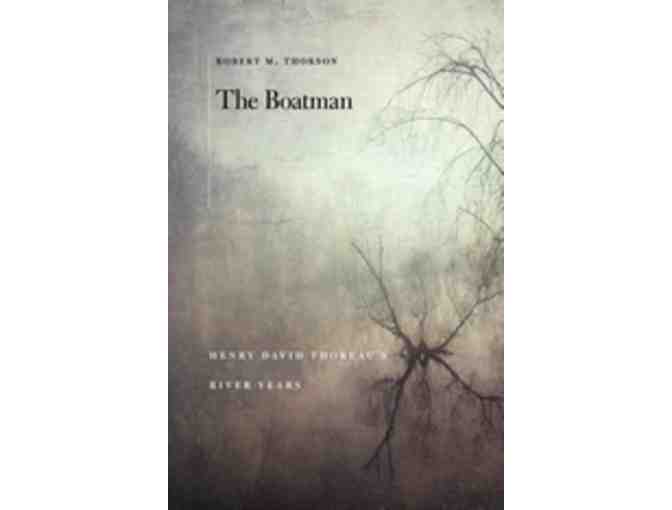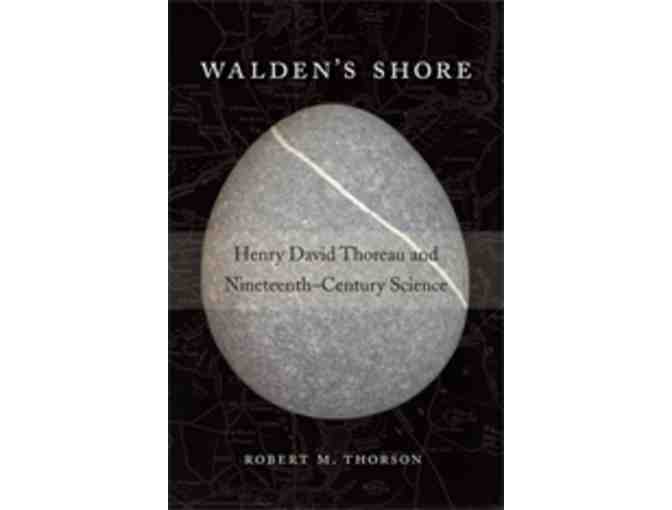Books
Robert Thorson Book Set "Walden's Shore (2015)" and "The Boatman (2017)" SIGNED BY AUTHOR
- Item Number
- 276
- Estimated Value
- 100 USD
- Sold
- 38 USD to revbma
- Number of Bids
- 2 - Bid History
Item Description
Hardcover book set of Robert M. Thorson's "Walden Shore: Henry David Thoreau and Nineteenth-Century Science" (published 2015) and "The Boatman: Henry David Thoreau's River Years" (to be published this April, 2017).
This hardcover book set will be signed and inscribed to your preference. Mr. Thorson can meet you within a year or mail these book copies sooner to preferred mailing address.
About the books (from Harvard University Press):
The Boatman gives readers a Thoreau for the Anthropocene epoch. As a backyard naturalist and river enthusiast, Thoreau was keenly aware of the way humans had altered the waterways and meadows of his beloved Concord River Valley. And he recognized that he himself—a land surveyor by trade—was as complicit in these transformations as the bankers, lawyers, builders, landowners, and elected officials who were his clients. Robert Thorson tells a compelling story of intellectual growth, as Thoreau moved from anger, to lament, to acceptance of the way humans had changed the river he cherished more than Walden Pond.
In his twenties, Thoreau had contemplated industrial sabotage against a downstream factory dam. By the mid-1850s he realized that humans and an “imperfect” nature were inseparable. His beliefs and scientific understanding of the river would be challenged again when he was hired in 1859 as a technical consultant for the River Meadow Association, in America’s first statewide case for dam removal—a veritable class-action suit of more than five hundred petitioners that pitted local farmers against industrialists. Thorson offers the most complete account to date of this “flowage controversy,” including Thoreau’s behind-the-scenes investigations and the political corruption that eventually carried the day.
In the years after the publication of Walden (1854), the river boatman’s joy in the natural world was undiminished by the prospect of environmental change. Increasingly, he sought out for solace and pleasure those river sites most dramatically altered by human invention and intervention—for better and worse.
-----
“Let us settle ourselves, and work and wedge our feet downward,” Thoreau invites his readers in Walden, “till we come to a hard bottom and rocks in place, which we can call reality.” Walden’s Shore explores Thoreau’s understanding of that hard reality, not as metaphor but as physical science. Robert M. Thorson is interested in Thoreau the rock and mineral collector, interpreter of landscapes, and field scientist whose compass and measuring stick were as important to him as his plant press. At Walden’s climax, Thoreau asks us to imagine a “living earth” upon which all animal and plant life is parasitic. This book examines Thoreau’s understanding of the geodynamics of that living earth, and how his understanding informed the writing of Walden.
The story unfolds against the ferment of natural science in the nineteenth century, as Natural Theology gave way to modern secular science. That era saw one of the great blunders in the history of American science—the rejection of glacial theory. Thorson demonstrates just how close Thoreau came to discovering a “theory of everything” that could have explained most of the landscape he saw from the doorway of his cabin at Walden. At pivotal moments in his career, Thoreau encountered the work of the geologist Charles Lyell and that of his protégé Charles Darwin. Thorson concludes that the inevitable path of Thoreau’s thought was descendental, not transcendental, as he worked his way downward through the complexity of life to its inorganic origin, the living rock.
Donated By:
The Thoreau Society and The Thoreau Farm Trust stores data...
Your support matters, so The Thoreau Society and The Thoreau Farm Trust would like to use your information to keep in touch about things that may matter to you. If you choose to hear from The Thoreau Society and The Thoreau Farm Trust, we may contact you in the future about our ongoing efforts.
Your privacy is important to us, so The Thoreau Society and The Thoreau Farm Trust will keep your personal data secure and The Thoreau Society and The Thoreau Farm Trust will not use it for marketing communications which you have not agreed to receive. At any time, you may withdraw consent by emailing Privacy@frontstream.com or by contacting our Privacy Officer. Please see our Privacy Policy found here PrivacyPolicy.


